ABOUT US
What’s behind FoodLoop?
FoodLoop developed an application in the form of a networked software solution for the food retail industry and the consumer. The tool consists of an enterprise resource planning (ERP) extension on the one side, and consumer-based applications on the other. Close-dated foodstuffs with a short remaining shelf-life are in the focus of interest. They shall be marketed beyond the store, and contrary to the usual practice, not end up up in the bin.
Keywords: food waste!
The food retail stores are now able to sell food products with a short remaining shelf-life as discount offers and to mark them automated in their ERP system. Subsequently, these offers are communicated to the consumer in real time via the FoodLoop App in its personalized profile. By means of this innovation, food waste is reduced in food retail, product and batch management is optimized, and consumers are promptly and individually informed about price offers.
How can I imagine the FoodLoop app in practice?
A food retail employee can read in appropriate foodstuffs via the barcode (GS1 DataBarTM or GTIN) with the application on a mobile device, which is coupled with the ERP system, and then provide the system with a discount. The foodstuff is also marked with a FoodLoop-sticker. Information such as type of food and discount amount will be displayed within seconds on the consumer´s smartphone, tablet or PC via free FoodLoopApp.


The app provides important food information to the consumer. Additionally, the app allows users to set personal preferences regarding food selection, point of purchase and providers can be adjusted and as well as push notifications. The availability of food is made easily understood by the use of traffic light signals. Once the consumer buys one discounted product , it is automatically entered into the ERP system by POS-scan and the product availability is updated in the app . In addition, FoodLoop has introduced the innovative GS1 DataBarTM on fresh and chilled products in the form of mobile printable stickers in cooperation with GS1®. This DataBar provides more information on product features such as best-before-date or use-by date, net weight and packaging.
Who benefits from this innovation?
FoodLoop offers a unique solution and service to
- avoid food waste, to reduce the CO2 footprint and to include the consumer actively and sustainably1
- offer affordable high-quality and fresh food products with a short remaining shelf life2
- create consistently positive customer experiences and appreciation for food1
- draft marketing campaigns based on customer preferences and buying patterns on an innovative surface
- communicate corporate sustainability (corporate sustainability reporting)3 and practice (corporate social sustainability)
- improve the environmental performance in food retail4
- optimize the sustainable supply chain management, within optimizing scheduling systems and commodity flows
- make food products more transparent and traceable
- renew freshness and product policy
- reduce costs
- design working time effectively
- increase sales
- embed digital and physical worlds innovatively1
In short, a holistic resource-saving solution for the environment, the consumer and the food retail sector in terms of sustainable development and economy.
What circumstances brought FoodLoop to develop this idea?
As downstream components, the food retail industry and the consumer are at the end of the food supply chain. Foodstuffs require a lot of resources during their production along this chain. Slightly more than a third of all produced foodstuffs are wasted. In high-income countries, the food retail and consumers are wasting most. During his private research Christoph Müller-Dechent found that many foodstuffs in food retail have already been sorted out several days before the expiry of best-before-date or use-by-date and ended up in the dumpster. The reasons were discussed in many conversations with those responsible in food retail: inefficient product and batch management and an internal freshness and quality policy were very frequently mentioned.
The following facts exemplify the full extent to the situation:
222 million tons of foodstuffs are wasted in high-income countries in wholesale/food retail and by consumers.5
- in food retail in GER: 550 000 tons of food worth about 1.3 billion Euros (according to the EHI Retail Institute 310 000 tonnes)6,7
- in 27 EU-countries: approx. 4.4 million tons of foodstuffs in food retail 2
- in USA in the food retail approx. 1.7 million tons foodstuffs8
- worldwide: 1.3 billion tons of produced food along the entire food chain, giving it a market price of $845 billion US9,10
Even more serious is the environmental burden of food waste, with effects on
- climate
- water and land resources
- biodiversity
- society
Wasting natural resources indirectly costs $1.6 trillion US!
All in all, food waste globally costs us $2.46 trillion US, which is approx. the GDP of the UK (2013) or 3% of global GDP (2013).10,11,12
Many people in the industry concerned, were very unhappy about having to throw away edible food, although sales offers already for foodstuffs with a short remaining shelf-life are already taking place. In a seminar at the University of Cologne, Christoph then developed the first idea of an app for consumers providing realtime discount informations of food retail. In this way the very short-term and limited discounts would be communicated efficiently in a smart manner. The idea to pair the ERP system on a platform with the consumer app was then added. The innovation was born and quickly found many interested parties and supporters!
Which goals are FoodLoop pursuing with the app?
With its system – and stakeholder connecting applications FoodLoop aims to
- drastically reduce the avoidable food waste
- use ecological and economic resources sustainably
- increase appreciation for food.
For the individual stakeholders specifically this means:
FoodLoop enables valuable and affordable food and personalized food informations to the consumer via the FoodLoopApp
FoodLoop offers the Food Retail Industry
- a service which reduces food waste and automates, optimizes and simplifies internal goods-specific processes,
- the ability to improve the environmental and economic performance
- a tool for innovative implementation of corporate sustainability and corporate marketing strategies
Pressure on the environment and society is relieved through the efficient utilization of existing resources.
A triple-win situation connecting environment, consumers and the actors in food retail in a sustainable und substantial way.
FoodLoop in 2025?
Definitely in every supermarket on earth!
Ambitious goals create motivation and incentives to make new thought-provoking impulses. We would make a valuable contribution to the resource efficiency with our innovation, minimizing the global impact of food waste and at the same time provide incentives. Abiding by the slogan: do good, save money!
Sources:
1. IBM – Erkenntnisse aus der IBM Global C-Suite Study – Deutschland. (2014, June 20). IBM Corporation. Retrieved from http://www-935.ibm.com/services/de/de/c-suite/csuitestudy2013/
2. BIO Intelligence Service. (2010). Preparatory Study on Food Waste across EU 27. Final Report. For European Commission (DG ENV) in association with AEA and Umweltbundesamt. doi:10.2779/85947
3. OECD. (2008). Promoting Sustainable Consumption. Good Practises in OECD Countries. Retrieved August 22, 2014, from http://www.oecd.org/greengrowth/40317373.pdf
4. BIO Intelligence Service. (2009). Towards a greener retail sector. Final Report. Prepared for European Commission (DG ENV) in association with GHK, Ecologic, TME and Ekopolitika. Retrieved from http://ec.europa.eu/environment/eussd/pdf/report_green_retail.pdf
5. Vermeulen, S. J., Campbell, B. M., & Ingram, J. S. I. (2012). Climate Change and Food Systems. Annual Review of Environment and Resources, 37(1), 195–222. doi:10.1146/annurev-environ-020411-130608
6. Kranert, M., Hafner, G., Barabosz, J., Schneider, F., Lebersorger, S., Scherhaufer, S., … Leverenz, D. (2012). Ermittlung der weggeworfenen Lebensmittelmengen und Vorschläge zur Verminderung der Wegwerfrate bei Lebensmitteln in Deutschland. Im Auftrag des Bundesministerium für Ernährung, Landwirtschaft und Verbraucherschutz. Stuttgart. Retrieved from https://www.zugutfuerdietonne.de/uploads/media/Studie_Lebensmittelabfaelle_Kurzfassung_02.pdf
7. EHI Retail Intsitute. (2011). Nahrungsmittelverluste im Lebensmitteleinzelhandel. Köln. Retrieved from http://www.ehi.org/fileadmin/images/content_images/Presse/Pressefotos/EHI_Studie_Lebensmittelverluste_LEH.pdf
8. BSR. (2013). Analysis of U.S. Food Waste Among Food Manufacturers, Retailers, and Wholesalers. Prepared for the Food Waste Reduction Alliance. Retrieved from http://www.foodwastealliance.org/wp-content/uploads/2013/06/FWRA_BSR_Tier2_FINAL.pdf
9. FAO. (2013). Food wastage footprint. Impacts on natural resources. Summary report. Rom. Retrieved from http://www.fao.org/docrep/018/i3347e/i3347e.pdf
10. El-Hage Scialabba, N. (2014). Full-Cost Accounting of Food Wastage. The Hidden Costs. 29th FAO Regional Conference for Europe. Rome, Bucharest. Retrieved from http://www.fao.org/fileadmin/templates/nr/sustainability_pathways/docs/FWF2_FAO_final_02042014.pdf
11. Kummu, M., de Moel, H., Porkka, M., Siebert, S., Varis, O., & Ward, P. J. (2012). Lost food, wasted resources: global food supply chain losses and their impacts on freshwater, cropland, and fertiliser use. The Science of the Total Environment, 438, 477–89. doi:10.1016/j.scitotenv.2012.08.092
12. The World Bank. (2014). GDP (current US$) – DataTable. Retrieved August 22, 2014, from http://data.worldbank.org/indicator/NY.GDP.MKTP.CD/countries/1W?display=default

